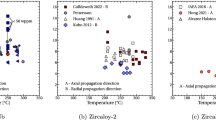Abstract
Pre-storage drying-transfer operations and early stage storage expose cladding to higher temperatures and much higher pressure-induced tensile hoop stresses relative to normal operation in-reactor and pool storage under these conditions. Radial hydrides precipitate during cooling and could provide an additional embrittlement mechanism as the cladding temperature decreases below the ductile-to-brittle transition temperature. To simulate this behavior, unirradiated Zircaloy-4 samples were hydrided by a gas charging method to levels that encompass the range of hydrogen concentrations observed in current used fuel. Mechanical testing was carried out by the ring compression test (RCT) method at various temperatures to evaluate the sample’s ductility for both as-hydrided and post-hydride reorientation treated specimens. As-hydrided samples with higher hydrogen concentration (>800 ppm) resulted in lower strain before fracture and reduced maximum load. Increasing RCT temperatures resulted in increased ductility of the as-hydrided cladding. A systematic radial hydride treatment was conducted at various pressures and temperatures for the hydrided samples with H content around 200 ppm. Following the radial hydride treatment, RCTs on the hydride reoriented samples were conducted and exhibited lower ductility compared to as-hydrided samples.
Similar content being viewed by others
References
M. C. Billone, Y. Yan, T. Burtseva, and R. Daum, “Cladding Embrittlement during Postulated Loss-of-Coolant Accidents,” NUREG/CR–6967 ANL-07/04 (2008).
Y. Yan, T. A. Burtseva, and M. C. Billone, “Post-quench Ductility Results for North Anna Highburnup 17×17 ZIRLO Cladding with Intermediate Hydrogen Content,” ANL letter report to NRC, April 17, 2009.
M. C. Billone, T. Burtseva, and Y. Yan. “Overview of Spent Nuclear Fuel Program: Test Plan and High Burnup Cladding at ANL,” NRC Program Review Meeting, Argonne National Laboratory, Argonne, IL, July 7, 2010.
R. Daum, H. Tsai, Y. Liu, and M. Billone, “High-Burnup Cladding Mechanical Performance during Cask Storage and Post-Storage Handling and Transportation,” Nuclear Safety Research Conference, Washington, D.C., October 25–27, 2004.
M. C. Billone, T. Burtseva, and R.E. Einzuger, “Dutile-to-Brittle Transition Temperature for High-Burnup Cladding Alloys Exposed to Simulated Drying-Storage Condition,” J. Nucl. Mater. 433, 431 (2013).
J. Cuta, “Temperature Histories in Typical Dry Storage Conditions,” Review Meeting of Argonne’s High-Burnup SNF Transport Program, Argonne, IL, July 7, 2010.
Y. Yan, A. S. Blackwell, L. K. Plummer, B. Radhakrishnan, S. B. Gorti, and K. T. Clarno, “Observation and Mechanism of Hydride in Zircaloy-4 and Local Radial Hydride Induced by High Pressure at High Temperatures,” 2013 International High-Level Radioactive Waste Management, Albuquerque, NM, April 28 – May 2, 2013.
Author information
Authors and Affiliations
Rights and permissions
About this article
Cite this article
Yan, Y., Plummer, L.K., Ray, H. et al. Ductility Evaluation of As-Hydrided and Hydride Reoriented Zircaloy-4 Cladding under Simulated Dry-Storage Condition. MRS Online Proceedings Library 1645, 103 (2014). https://doi.org/10.1557/opl.2014.248
Published:
DOI: https://doi.org/10.1557/opl.2014.248



